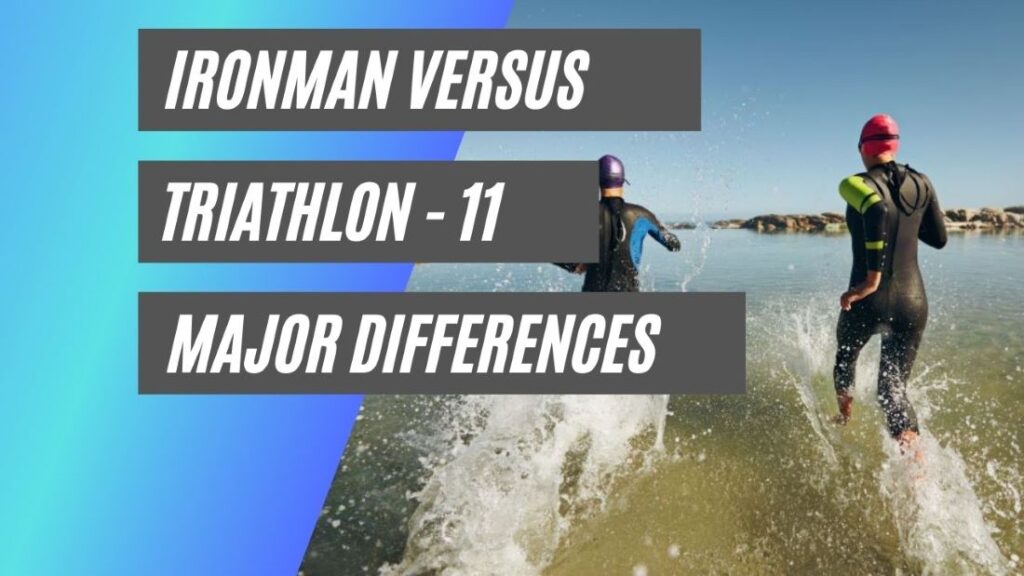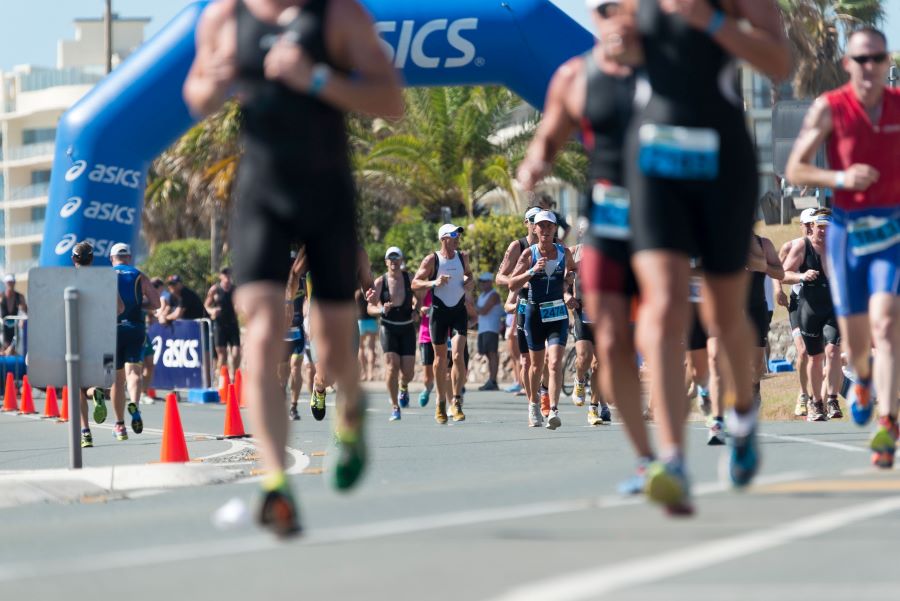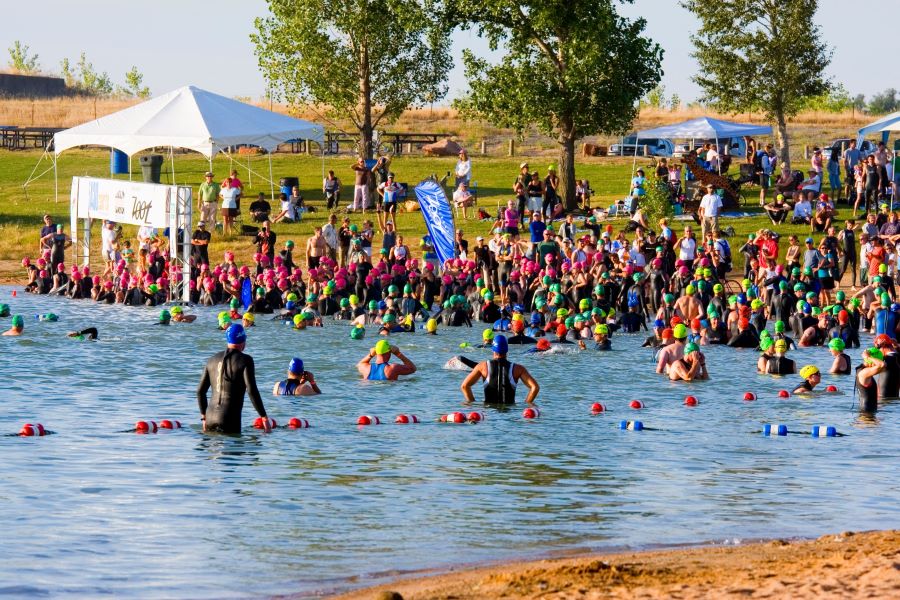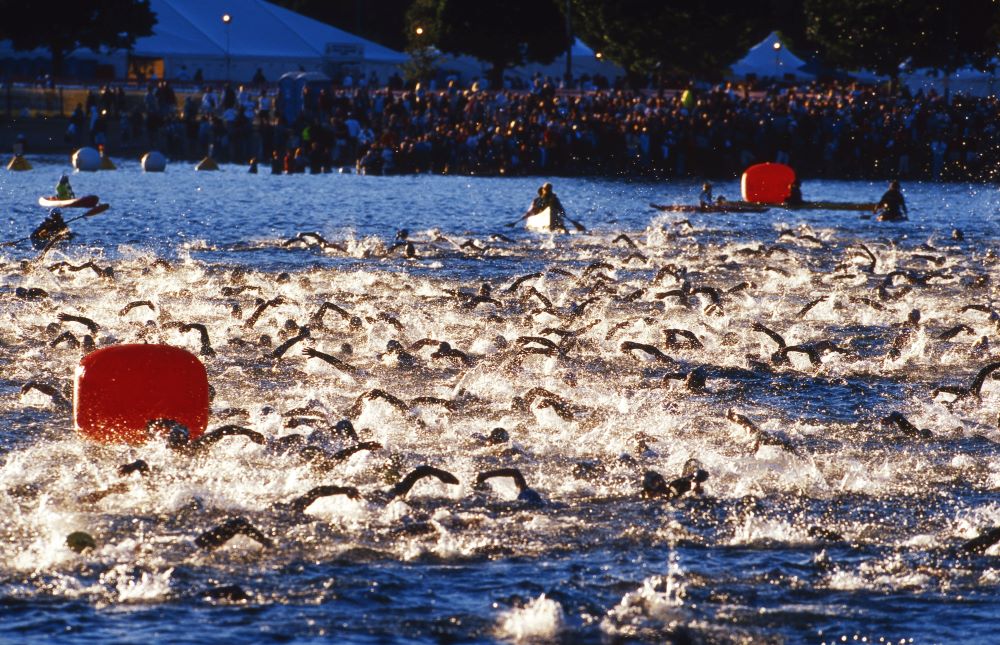This post may contain affiliate links. If you click an affiliate link and make a purchase, I may earn a commission. Also, as an Amazon Associate, I earn from qualifying purchases.--
Both Ironman and Triathlon are similar events, comprising the same structure of long-distance swim, cycle, and then run.
An Ironman is simply a much longer version of a triathlon, but this leads to the fact that there are at least 11 major differences between the two events. These are:
1. Swimming distance
2. Cycling distance
3. Running distance
4. The Ironman Brand
5. Duration of the Race
6. Training Requirements
7. Recovery Time After a Race
8. Degree of Endurance Required
9. Role of Nutrition and Hydration
10. Relative Ease as a Beginner
11. Expenses
Around 4 million people in the United States participate in triathlons each year (Source) and many more train for one, for reasons ranging from mental satisfaction and improvement of physical fitness to simply wanting a hobby.
In this post, I’ll describe in detail the 11 differences between Ironman and Triathlon.

What is an Ironman?
Being a form of triathlon, an Ironman also includes a consecutive combination of swimming, cycling, and running.
However, it is the king of triathlons.
While a triathlon can use any distance for swimming, cycling, and running (although standardized distances are widely used), an Ironman involves strict adherence to a trademarked distance of 2.4 miles swimming, 112 miles biking, and 26.2 miles of running.
This is considerably longer than a sprint triathlon or an Olympic triathlon, making it one of the most prestigious and hardest races to exist.
Completing this behemoth of a triathlon is on my bucket list too!
11 Differences Between Triathlon and Ironman
1. Swimming Distance
Usually taking place in open water rather than a swimming pool, the first component of a triathlon or an Ironman is swimming.
When the Ironman was first conceptualized, the goal was to compare the difficulty level (in terms of resistance) of the 2.4-mile-long Waikiki Roughwater Swim, a 112-mile bike ride around Oahu (now known as the Dick Evans Memorial Road Ride or DEMRR), and the Honolulu Marathon spanning 26.2 miles.
Consequently, an Ironman swimming distance is 2.4 miles or 3.86km long.
The exact half of this distance (1.2 miles) is swam in a triathlon known as a Half Ironman, whereas the length in an Olympic level triathlon is one mile (1.5km).
Additionally, a sprint triathlon requires the participant to swim only 750 meters (half a mile).
While these are standardized triathlon distances widely in use, a triathlon organizer has full liberty to modify these distances according to their needs and preferences.
2. Cycling Distance
Making up 50% of the race, the Ironman biking length lasts 112 miles i.e. 180.26km, based on the distance involved in the Oahu bike race, and similar to how it worked in swimming, a half ironman contains 66 miles.
On the other hand, Olympic-level and sprint triathlons include shorter cycling distances.
An Olympic triathlon includes a 12.4-mile (40km) cycle, while a sprint tests half of that i.e. 6.2 miles (20km).
3. Running Distance
Following the same principles as the above two sports, an Ironman requires participants to run 26.2 miles (42.195km) which is as long as a marathon.
More specifically, it is the length of the Honolulu marathon. A half Ironman run spans 13.1 miles.
On the contrary, the running distances of an Olympic level triathlon and a sprint triathlon are 6.2 miles (10km) and 3.1 miles (5km) respectively.
Here’s a table that summarizes the information about distances so far:
| Sprint Triathlon | Olympic Triathlon | Half Ironman | Ironman | |
| Swim Distance (miles) | 0.5 | 1 | 1.2 | 2.4 |
| Cycling Distance (miles) | 6.2 | 12.4 | 66 | 112 |
| Run Distance (miles) | 3.1 | 6.2 | 13.1 | 26.2 |

4. The Ironman Brand
As explained above, triathlons can be organized over any combination of distances, the most common of which are the Olympic-level triathlons and the sprint triathlons.
Anyone can organize a triathlon, and should their distances be a 2.4-mile swim, 112 miles cycling, and a 26.2-mile run, that triathlon would be termed an ‘Iron-distance race’.
Independent companies are legally prohibited (Source) to use the term ‘Ironman’ because it is a brand trademarked and owned by the World Triathlon Corporation (WTC).
Consequently, ‘Ironman’ is the only company that can arrange Ironman races and it is one of the largest triathlon event organizers globally.
Similarly, a half Ironman, also known as Ironman 70.3 (70.3 being the total number of miles across all three sports), is also a trademark.
Since a triathlon does not have intellectual property implications, any independent company can arrange a triathlon.
5. Duration of the Race
Given the enormous difference in the distance of the races, a triathlon and an Ironman also differ in how long it takes to finish it.
10% of either race takes up swimming, 50% of the time is spent on biking, 38% on running, and the remaining 2% is utilized in transition between the sports.
Most people who participate in an Ironman take between 12 and 14 hours to finish the race, while those new to the sport exceed the upper limit.
17 hours is the duration at which the race is capped, after which the option to finish it is taken away.
The world record for completing an Ironman championship in the minimum time is held by Jan Frodeno of the United States at 7 hours, 51 minutes, and 13 seconds. (Source)
A half Ironman usually takes five to seven hours to complete, while the time duration for an Olympic triathlon falls between 1.5 and 2 hours for an experienced athlete and longer than 2 hours for an amateur.
Finally, a sprint triathlon usually takes less than 1.5 hours to finish, the fastest time to finish it being 51 minutes and 15 seconds (Mario Mola of Spain).
6. Training Requirements
In a triathlon, each sport requires a unique skill set and specific preparation that needs to be undertaken to do well in a triathlon.
For swimming, the participant needs to develop familiarity with water while getting some mileage on their legs before such a long run.
Training for a triathlon is highly intensive, needing consistent and strenuous workouts while being mindful of the toll it would take on mental health.
An Ironman is way more difficult than a regular triathlon and thus, its training is longer and more rigorous.
While a novice can prepare for a sprint triathlon in 3-4 months (4-6 weeks for experienced triathletes) and an Olympic triathlon in 4-5 months (6-12 weeks for experts), an Ironman demands consistent training for around a year.
Even experienced triathletes need 4 to 6 months before participating in an Ironman.

7. Recovery Time after a Race
The physical and mental fatigue that follows the exhausting and regular training of triathlon and the event itself is unparalleled, which is why engaging in something as intensive immediately after is contraindicated.
If someone participates in a sprint triathlon, it should be followed by two days of complete rest and then seven days of light exercise before trying something rigorous.
Noting the difficulty level (15 hours of non-stop exercise) of an Ironman and how it is one of the hardest sports to compete in physically, its recovery period includes a complete week of rest and then 21 days of steady exercise before returning to normalcy.
For some people, it may take up to 3 months before they feel equipped to try an intensive workout regimen.
Recovery in a triathlon is so crucial that it can be referred to as the ‘fourth discipline’.
8. Degree of Endurance Required
It is no secret that participating in an Ironman requires a high degree of fitness, to be able to withstand the physical toll 15 hours of sports takes on them.
They require significant endurance, the ability to sustain the prolonged effort, and the practice of rationing their strength across all three disciplines.
They start slow, saving energy, so they can finish the race.
It is called an Ironman because initial rules demanded that ‘whoever finishes first, we shall call him the Ironman’ due to the resilience and indestructibility it took to accomplish this feat.
Since a regular triathlon is shorter, the degree of endurance it requires is lower.
However, that does not mean it is an easy task. Since a sprint or an Olympic triathlon are shorter, the time needed to catch up if fallen behind is too little.
Therefore, those are performed with high intensity, and participants are expected to perform to their maximal potential throughout the race, making the whole process extremely tiring.
9. Role of Nutrition and Hydration
As discussed above, training for a triathlon is highly demanding.
A regular commitment to working out is a given, but major lifestyle changes are not entirely needed.
However, graduating from an Olympic triathlon to a half Ironman or an Ironman means a greater emphasis on nutrition in the participant’s lifestyle.
Since Ironmans require continuous exercise for extended periods, the body will experience its effects. They will want to eat a lot, but it is important to not succumb to cravings and maintain a healthy diet with an optimal balance of proteins, carbs, and healthy fat.
Eating 20-30g of protein within the 30-to-45-minute window after an intensive workout is highly recommended, and regular hydration (sipping throughout the day) is a habit to be inculcated.
All of this is not as important when training for a triathlon.
Additionally, nutrition also has a huge role during the event itself. Since an Olympic triathlon will end after 3 hours, participants can afford to not eat food for the duration of the event, but that expectation no longer exists in a 14-hour event.
Participants of an Ironman are expected to sip continuously, consume at least 90g of carbohydrates per hour (through carb-rich food such as rice cakes and peanut butter and jam sandwiches in bite-sized chunks), and feed every 15 to 20 minutes after the swim portion of the race.
10. Relative Ease as a Beginner
An Ironman is a tempting activity, which is why a notable number of participants in the premier Hawaii Ironman World Championship are people who have never done a triathlon before.
While it is certainly possible to do so with a long and rigorous training schedule that incorporates race simulations to attain familiarity with the distance, this steep learning curve is not easy at all.
Instead of putting oneself through something so extreme, a sprint triathlon is a more popular approach to breaking into this multisport world of triathlon.
It does not warrant extreme lifestyle changes and slowly moving up the ladder to an Olympic triathlon and then a half Ironman is not only more comfortable, but it builds the aerobic base and muscle strength to do well and ensure safety in the Ironman they eventually end up running.

11. Expenses
Like any other sport, a triathlon is also not cheap. However, any money put into it is an investment. Triathlons and an Ironman differ in both: the entry fees for the race and the pre-event expenses.
Arranging a triathlon involves expenses ranging from venue and safety measures for the swim to marketing, closing public highways, and delivering a safe and memorable experience.
Resultantly, the entry fees for such events are high (discounts and sponsorships are available) and as a rule of thumb, the longer the distance, the higher the fee.
Since Ironman is a brand, those events cost even higher.
People can expect to pay around $600-$800 for an Ironman but local triathlons even start at $50, with very elite events being as high as $500.
Pre-event expenses include investment in gear such as wetsuits, swim caps, goggles, a bike, helmet, running shoes, and triathlon licenses.
As you participate in longer and harder events such as the Ironman, the need for premium (and more expensive) products rises, making the total cost of participating in an Ironman much higher than that of a regular triathlon.
The Bottom Line
In the world of triathlons, an Ironman race sits near the top. While they are both similar in terms of the sports played, the differences between the two are many – different distances, unique training, recovery, endurance, and nutrition requirements, and the logistics – to confuse the two.
Either way, both are extremely challenging races to participate in.
Regular triathlons are the ideal steppingstones before participating in an Ironman. Training for both requires immense commitment and effort, but the joy of finishing those races is an unexplainable feeling that makes everything else worth it.
